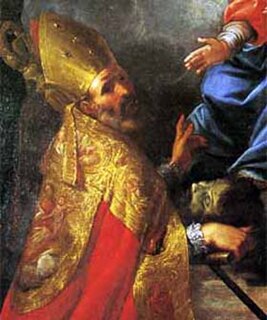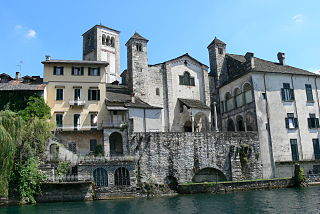Eusebius was a Roman historian, exegete and Christian polemicist.

Saint Lawrence or Laurence was one of the seven deacons of the city of Rome under Pope Sixtus II who were martyred in the persecution of the Christians that the Roman Emperor Valerian ordered in 258. Lawrence encountered the future Pope Sixtus II, who was of Greek origin and one of the most famous and highly esteemed teachers, in Caesaraugusta. Eventually, both left Spain for Rome. When Sixtus became the Pope in 257, he ordained Lawrence as a deacon, and though Lawrence was still young appointed him first among the seven deacons who served in the cathedral church.

Eusebius of Vercelli was a bishop from Sardinia and is counted a saint. Along with Athanasius, he affirmed the divinity of Jesus against Arianism.

Lucifer of Cagliari was a bishop of Cagliari in Sardinia known for his passionate opposition to Arianism. He is venerated as a Saint in Sardinia, though his status remains controversial.

Guglielmo Caccia called il Moncalvo was an Italian painter of sacred subjects in a Mannerist style.
Auxentius of Milan or of Cappadocia, was an Arian theologian and bishop of Milan. Because of his Arian faith, Auxentius is considered by the Catholic Church as an intruder and he is not included in the Catholic lists of the bishops of Milan such as that engraved in the Cathedral of Milan.

Saint Philastrius Bishop of Brescia, was one of the bishops present at a synod held in Aquileia in 381. St. Augustine met him at Milan about 383, or perhaps a little later. He composed a catalogue of heresies about 384. He died before 397.

Saint Gaudentius was Bishop of Brescia from 387 until 410, and was a theologian and author of many letters and sermons. He was the successor of Saint Philastrius.

Novara is the capital city of the province of Novara in the Piedmont region in northwest Italy, to the west of Milan. With 101,916 inhabitants, it is the second most populous city in Piedmont after Turin. It is an important crossroads for commercial traffic along the routes from Milan to Turin and from Genoa to Switzerland. Novara lies between the rivers Agogna and Terdoppio in northeastern Piedmont, 50 kilometres (31 mi) from Milan and 95 kilometres (59 mi) from Turin.

The Roman Catholic Archdiocese of Vercelli is a Latin rite Metropolitan see in northern Italy, one of the two archdioceses which, together with their suffragan dioceses, form the ecclesiastical region of Piedmont.

Saint Gratus of Aosta was a bishop of Aosta and is the city's patron saint.

Simplician was Bishop of Milan from 397 to 400 or 401 AD. He is honoured as a Saint in the Roman Catholic and Eastern Orthodox Churches and his feast day is August 14.

Maurilio Fossati, O.SS.G.C.N., was an Italian Cardinal of the Roman Catholic Church who served as Archbishop of Turin from 1930 until his death, and was elevated to the cardinalate in 1933.

Calimerius was an early bishop of Milan. He is honoured as a Saint in the Catholic and Eastern Orthodox churches and his feast day is on July 31.

Saint Vigilius of Trent is venerated as the patron saint and bishop of Trent. He should not be confused with the pope of the same name.
The Synod of Milan or Council of Milan may refer to any of several synods which occurred in late Roman Mediolanum or medieval Milan in northern Italy's Po valley:

Saint Gaudentius of Rimini was born in Ephesus in Asia Minor. In 308 he migrated to Rome and was baptized. In 332 he was ordained as a priest and fourteen years later consecrated as a bishop. He was then sent to Ariminum where he became the first bishop of that city. In 359, he attended the Council of Rimini called by the Roman Emperor Constantius II, specially convened to condemn Arius. After attacking the beliefs of Arianism, he was arrested by the emperor's representative and then kidnapped from the authorities and lynched by the followers of Arius. He is honored as a martyr by the Catholic Church.

Dionysius was bishop of Milan from 349 to 355. He is honoured as a Saint in the Catholic and Eastern Orthodox Churches and his feast day is 25 May.

The Basilica di San Giulio is a Roman Catholic church on the small Isola San Giulio in the center of Lake Orta, province of Novara, north-western Italy. It has the status of a minor basilica. Although the island is part of the Orta San Giulio municipality, the basilica belongs to the San Giacomo parish, including the island and a portion of the west coast of the lake in San Maurizio d'Opaglio municipality.

Saint Eustasius of Aosta was the first bishop of the ancient see of Augusta Pretoria, today Aosta. His name is attached to a letter sent to Pope Leo I by the delegates of the second Synod of Milan (451).

















